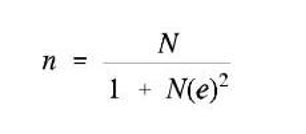
One question many marketers have is this: How many surveys do I need for my market research study? Or, how do I calculate survey sample size so I can be sure I’m statistically valid?
First, I’ll give you a quick answer, assuming you have a total population (N) over 1000, and you don’t want to survey all of them, you just want a few of them (n).
For a 95% confidence interval +/- 5% margin of error (the normal industry standard), if your population (N), i.e. the pool from which you’re drawing your sample, is 5000 OR MORE, you’ll want 385 – 400 surveys. If it’s a little smaller, say 4000, you’ll want 363 minimum, at 3000, you’ll need 353, at 2000, you’ll want 333, and at 1000, 286 is enough.
For smaller populations, you can easily calculate it on a calculator – scroll down to next heading – How to Calculate Sample Size on a Calculator.
The calculation is based on this simple formula, which assumes the industry standard of a 95% confidence and maximum variability (which means a wise/conservative estimate) in your sample:

- N is your population, i.e. the total pool you are sampling from. This is what your sample must represent. E.g. you have 100.
- e is the acceptable margin of error. Industry standard here is 5%, so plug in 0.05.
- n is the sample size (or number of surveys) you will need.
Using the above formula will result in data with a 95% confidence interval, meaning 19/20 times that you repeat the survey (because 1/20 is 5%), you would get the same result, within a +/- 5%.
How to Calculate Survey Sample Size on a Calculator
Suppose you think your population is N = 1000. Using Yamane’s formula and allowing a +/- 5% margin or error, this means your sample size, n = 1000 / (1+(1000*0.05*0.05)) = 285.71, rounding up to 286. Using a basic calculator, you would punch in numbers in the inside brackets first (1000 times 0.05 times 0.05, then hit equals, then add 1, and set that number aside. This gives 3.5. Then do the division: 1000/3.5 = 285.71, rounding to 286.
Note that the rest of the numbers in this formula stay the same. The only one that changes is the N, the population size. In this example, you’d want to survey at least 286 people for good statistical accuracy.
If you don’t know your population size exactly, make a rough estimate. Anything over 5000 is going to result in a sample size approaching 400.
Number of Participants from a Very Small Population
If your total population is under 100 (e.g. you want to know what your 100 customers think), it may be best to survey all of the people in the population, as the Yamane calculation gives a sample recommendation of 81 surveys anyway – and that’s practically everyone. And that also means the customers who don’t get asked are going feel excluded, right?
While it’s true you can design and execute your own survey through a tool such as Survey Monkey, you must be very careful about sampling error and question design. When the sample is not random, your numbers can give you biased or incorrect answers in comparison to what would represent your actual target customers.
Measuring Groups within Populations
If you have groups of people within a population to analyze, you may want to increase your sample size. For example, say want to know what male vs. females think, you may want to consider doubling your sample size to ensure statistical significance.
Another example here may be measuring male and female opinions within different regions, for example if you have 2 groups and 2 regions, you would want to multiply your sample size by 4 to ensure accurate data.
What about Qualitative Surveying?
Keep in mind that the above numbers are intended to achieve precision a quantitative survey, where numbers are of utmost importance and accuracy, such as polling for political party support. If you are looking for more “qualitative” answers – such as why people may be voting in different ways, other methods are generally preferred. These include techniques such as focus groups or in-depth interviews, and can often be done with much smaller numbers – in the 10 – 30 participants range.
We’re happy to answer questions, contact us today, or click to learn more about Tenato’s market research services.

